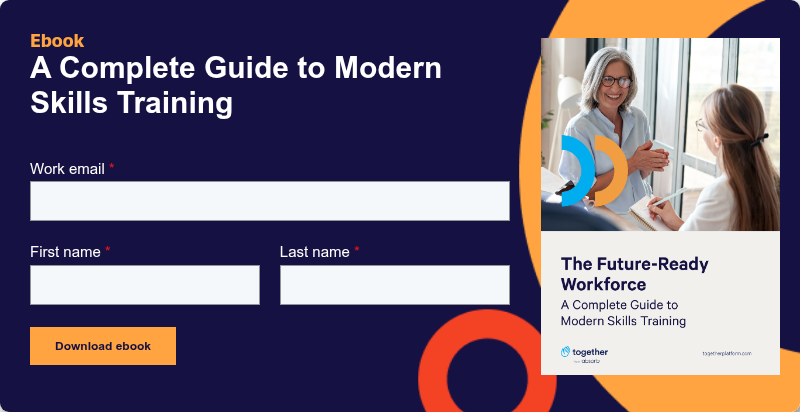For years, soft skills were the quiet guests at the workplace table—present, polite, but rarely the focus of conversation. But as AI and remote work rewrite office dynamics, these unmistakably human qualities are moving to the head of the table.
The soft skills once considered 'bonus' are now recognized as business essentials: like empathy, adaptability, creativity, and communication. Research from MIT Sloan found soft skills training yields a 250% return on investment, based on higher employee productivity and retention.
So, how can you use soft skills training to build and strengthen your organization?
What is soft skills training?
Soft skills training develops the interpersonal abilities employees need to work well with others, solve problems, and lead effectively. It focuses on enhancing qualities such as:
- Emotional intelligence
- Communication
- Teamwork
- Empathy
- Critical thinking
- Conflict resolution
- Time management
Soft skills training for employees typically involves interactive workshops, group discussions, role-playing scenarios, and practical exercises, often in classroom or virtual settings. Programs can last anywhere from a few hours to several weeks, giving participants time to actively practice and refine their skills.
What are some examples of soft skills training?
What does soft skills training look like in practice? It depends, as soft skills training may focus on a number of different areas. Here are a few examples:
Communication skills training for employees
Focuses on effective verbal and written communication, feedback, active listening, and presentation skills. It enhances clarity, reduces misunderstandings, and strengthens relationships across teams.
Time management training for employees
Time management training teaches prioritization, scheduling, and prevents burnout through techniques like goal-setting and apps. Helps employees work efficiently and manage workloads with less stress.
Email etiquette training for employees
Involves writing clear, concise, and professional emails, as well as understanding when to use email versus other communication tools. This helps reduce communication conflict, while encouraging transparency and accountability.
Interpersonal skills training for employees
Strengthens key interpersonal skills like teamwork, empathy, emotional intelligence, and conflict resolution. Teaches employees how to collaborate and solve problems quickly so they can be more productive.
Customer service training for employees
Customer service training covers communication, empathy, problem-solving, and patience in customer interactions. This training often leads to higher customer satisfaction, stronger client relationships, and increased brand loyalty.
Workplace culture training
Informs new and existing employees about company values, collaboration norms, leadership principles, and resources. Helps your teams align with and contribute to a thriving workplace culture.
Critical thinking training for employees
Analyzing complex or evolving situations, questioning assumptions, and making better decisions are all part of critical thinking. Critical thinking training helps employees improve problem-solving and opens the door to innovation.
These skills are most powerful when developed together. For example, use a combination of communication, time management, and critical thinking training for more impact.
8 ways to deliver soft skills training
While there’s no one-size-fits-all approach, the best training programs use varied methods. This keeps things interesting while catering to different learning styles.
Below are 8 proven methods, each with its own benefits and challenges. Choose the approaches that fit best with your needs, budget, and training goals.
1. Mentorship programs
Mentorship is one of the best soft skills training methods for employees – especially when it comes to communication and leadership. In a mentorship program, you pair employees (often a less experienced mentee with a more experienced mentor) to facilitate knowledge transfer, coaching, and personalized feedback.
Unlike one-off training sessions, mentoring provides ongoing social learning, which is a key aspect of professional development.
Benefits:
- Provides personalized, practice-based development
- Builds leadership and communication skills for both mentees and mentors
- Increases employee retention (50% higher retention rate for those in mentorship programs)
- Scalable for organizations of any size
- Cost-effective compared to external training
Drawbacks:
- Requires structure and planning to be effective
- Development takes months, not days
- Needs buy-in from leadership and proper training for mentors
Example: Google’s "g2g" (Googler-to-Googler) program is a peer mentoring environment where employees consult one another on a variety of topics, including soft skills like leadership and communication. Approximately 80% of Google’s employee training happens through this internal peer-to-peer model.
Programs like this highlights mentorship’s unique ability to deliver soft skills training in a relatable, engaging way.
Pro Tip: Structure is Key to Successful Mentoring
When launching a mentoring program, make sure to set clear goals and provide mentor training. Even a simple orientation on session structure and giving constructive feedback boosts mentorship quality.
Encourage participants to establish communication norms, set a specific goal (e.g., improving presentation skills), and track progress. A thoughtful mentorship program structure ensures the relationships lead to tangible skill development.
2. E-learning and online courses
E-learning platforms and Learning Management Systems (LMS) provide a library of online courses, videos, or interactive modules that employees can take at their own pace.
Topics can range from “Effective Communication 101” to advanced leadership courses. This method shines for teaching concepts and frameworks; for example, a course on communication skills training for employees might include video lectures on body language, quizzes on key concepts, and interactive scenarios to practice responding to a tough client email.
Benefits:
- Cost-effective and scalable across large teams
- Flexible, allowing employees to train on their own schedule
- Engages learners with microlearning, gamification, and simulations
Drawbacks:
- Engagement may drop without instructor or peer interaction
- Limited practice opportunities for skills like empathy or conflict resolution
Example: If you’re a mid-size customer service company, you might roll out an online customer service training for employees that covers listening skills and de-escalation techniques. Employees complete interactive lessons on their own time, while you track completion and scores through the LMS (an easy way to measure participation).
To bring it to life, you can also follow up with team role-plays during staff meetings, using what was learned online. This mix of digital learning and real interaction helps employees learn by doing.
3. Instructor-led workshops and seminars
It may be traditional, but it’s still one of the best ways to deliver soft skills training that sticks. Trainer-led workshops and seminars make learning interactive: discussions, group exercises, role-playing activities, and immediate feedback.
For example, you might organize a half-day workshop on interpersonal skills training for employees where a facilitator leads exercises on conflict resolution. Participants can practice a difficult conversation in pairs while the instructor coaches them in real time.
Benefits:
- Provides hands-on practice and real-time feedback
- Engaging format promotes discussion and sharing experiences
- Great for complex soft skills like emotional intelligence
Drawbacks:
- Less scalable and more costly than e-learning
- Requires careful scheduling and can be difficult to coordinate across multiple locations
Example: Imagine you’re hosting an email etiquette training seminar. In the session, the facilitator might show examples of poorly written emails and have groups rewrite them more clearly. Employees could discuss tone, organization, writing clearly, and using direct (but not harsh) language. You could also create custom email GPTs for employees based on brand style and tone of voice.
4. On-the-job training and job shadowing
Experience is a master teacher. On-the-job training (OJT) happens through real work tasks, projects, and day-to-day interactions. For example job shadowing, which allows employees to learn from colleagues by observing them perform their tasks (invaluable for real-time learning in the context of work).
For example, you could assign a junior software developer to shadow a senior colleague throughout an entire project. They’ll learn the steps to complete the task, while also building communication, time management, and team coordination skills.
Benefits:
- Encourages real-world application of skills and reinforces learning
- Tailored to employee’s roles and responsibilities
- Promotes higher retention through hands-on experience
Drawbacks:
- Learning can be inconsistent if not structured
- Employees may make mistakes without proper guidance
Example: Stretch assignments (a project or task that requires skills and experience beyond an employee’s current job responsibilities) are a good example of leadership development.
With stretch assignments, you’ll identify a high-potential employee and put them in charge of a project, such as launching a small new product feature. Suddenly, this employee has to coordinate developers, communicate updates, manage timelines – essentially a crash course in soft skills like communication, problem-solving, and team leadership. They will learn far more in those few months of experience than they might in a theoretical course.
5. One-on-one coaching
Coaching is similar to mentoring but typically involves a professional coach (internal or external) working one-on-one with an employee to develop specific skills or behaviors. Where mentors are usually other employees focusing on broader development, coaches are often experts focusing on targeted improvement with a set timeframe or goal.
Coaching is widely used for leadership development – for example, a new executive might get an external coach to improve their communication style and emotional intelligence in leading teams. Even a tenured employee could be coached on time management or customer interaction techniques.
Benefits:
- Deeply personalized and role-specific
- Provides tailored, immediate feedback to accelerate improvement
- Encourages goal-setting and accountability
Drawbacks:
- Resource-intensive and not scalable for all employees
- Requires skilled coaches, and not all managers are naturally good coaches
Example: Imagine an employee who consistently struggles with public speaking; their presentations lack confidence, they stumble over their words, or they don’t engage the audience. Any of these situations is hurting their leadership presence.
You might assign them a coach specialized in presentation skills for a 3-month period. Through one-on-one sessions, the coach identifies the employee’s main issues as anxiety and lack of structure in storytelling. They practice breathing techniques, organize a presentation together, and even do mock presentations on video for critique.
After weeks of practice and feedback, the employee delivers a successful presentation at an all-hands meeting; a night-and-day improvement from before. This targeted coaching on communication not only helps that individual but also benefits the company with more effective meetings and knowledge sharing.
6. Peer learning and social learning programs
People usually learn better from peers. Peer learning initiatives create structures for employees to learn with and from each other, rather than always from a formal instructor. This could take the form of peer-led training sessions (e.g., employees teaching workshops in their expertise), learning circles or clubs, or cross-department knowledge sharing groups.
Benefits:
- Builds a continuous learning culture
- Encourages collaboration and cross-functional learning
- Cost-effective and driven by internal expertise
Drawbacks:
- Quality varies depending on the peer instructor
- Needs facilitation to ensure information is relevant and accurate
Example: One example is a “lunch and learn” series where employees volunteer to present on a topic – one week it’s “Excel tips” (a hard skill), the next it might be “handling difficult client calls” (a soft skill) led by a veteran account manager. Another peer learning model is group mentoring or peer coaching circles, where small groups meet to discuss challenges and share advice.
7. Microlearning and bite-sized resources
In an age of shrinking attention spans and busy schedules, microlearning is a modern way to deliver training – including soft skills – in bite-sized pieces. Microlearning refers to very short learning activities or content, typically just a few minutes long, that focus on a narrow topic or tip.
For soft skills, this might be a daily two-minute video with a communication tip, a short article or infographic on mindfulness, a dedicated Slack channel for sharing resources, or a quick scenario question sent via a mobile learning app. The idea is to integrate learning into the daily workflow, rather than requiring employees to dedicate specific hours to training.
Benefits:
- Flexible and easy to implement
- Great for reinforcing learning and quick skill transfer
- Helps overcome time constraints by offering short, manageable lessons
Drawbacks:
- Cannot cover complex skills in-depth
- Requires engagement to be effective
Example: A company sends its employees a 2-minute video every Monday morning via their internal chat platform. One week covers "How to say no professionally," another focuses on "Active listening in client calls." Employees watch during their coffee break and can immediately apply the tip that same day or week.
Over time, these small, consistent lessons build up—employees report feeling more confident in daily interactions without ever attending a formal training session.
8. Simulations and role-playing exercises
For soft skills that are best learned by doing, simulations and role-play provide a safe yet realistic practice ground. This puts employees in a lifelike scenario where they must use soft skills to succeed. Traditional role-playing might involve two employees acting out, say, a manager-employee feedback session or a difficult client interaction, often observed by others who then provide feedback.
Advanced simulations use technology. For example, virtual reality (VR) training modules can stimulate public speaking in front of a virtual audience. Or, an AI-based chatbot can simulate an upset customer for a service rep to practice de-escalation.
The goal is to mimic real challenges as closely as possible so that employees can practice responses and behaviors in a controlled environment.
Benefits:
- Provides experiential learning without real-world consequences
- Builds confidence and muscle memory for handling real-world situations
- Effective for high-stakes skills like public speaking or conflict resolution
Drawbacks:
- Requires preparation and facilitation
- Can be awkward for introverts
Example: A customer service department could use role-playing to practice handling upset customers. One employee acts as the customer, while another practices de-escalation techniques. Afterward, the group discusses what went well and what could be improved.
Bringing it all together: A blended approach
The most effective training programs combine multiple methods. For instance, a communication training program for managers might start with an e-learning course, followed by a two-day workshop, and end with mentoring. This blended approach leverages the strengths of each method and ensures the program doesn’t get boring over time.
By aligning soft skills training with real-world opportunities, such as stretch projects and job shadowing, you can maximize the impact of training. This approach mirrors the 70:20:10 model, which emphasizes the importance of hands-on experience (70%), complemented by social learning (20%), and formal training (10%).
Empower employees with soft skills training
Technical expertise might get employees through the door, but soft skills determine their success once they are inside.
Soft skills training creates more adaptable teams, improves communication, strengthens leadership, and cultivates a positive workplace culture. Combining multiple delivery methods—like workshops and practice—engages employees and reinforces key skills over time.
Ready to take your skills training to the next level? Download our free eBook for proven strategies and insights on building effective training programs: The Future-Ready Workforce - A Complete Guide to Modern Skills Training.



.svg)







.svg)

